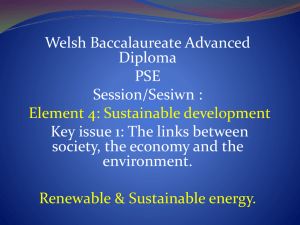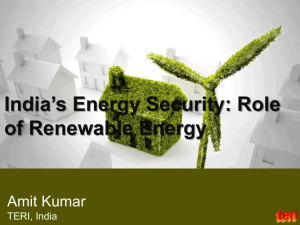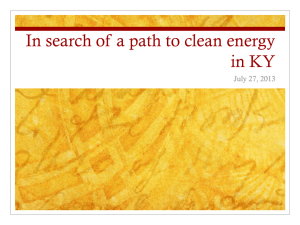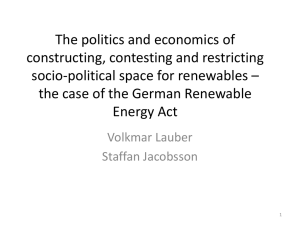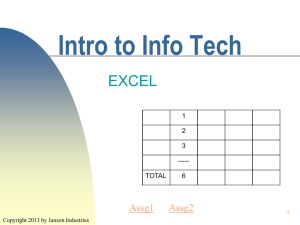Conference Düsseldorf
advertisement
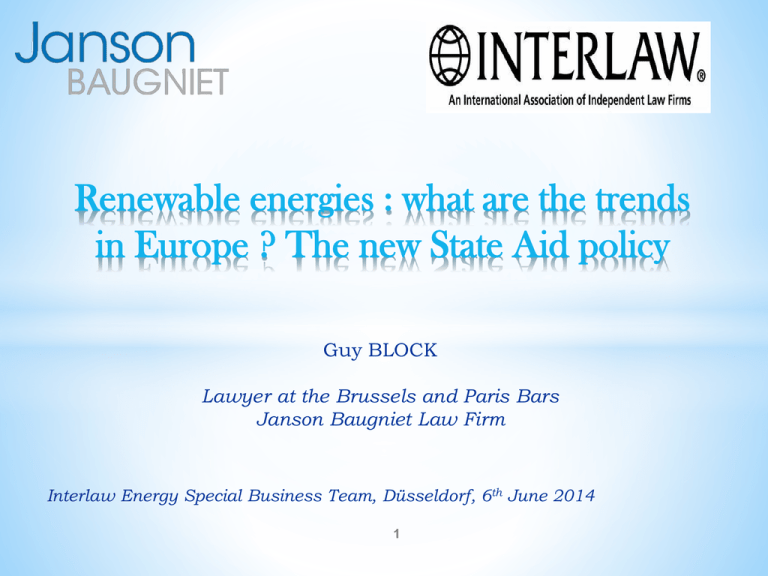
Renewable energies : what are the trends in Europe ? The new State Aid policy Guy BLOCK Lawyer at the Brussels and Paris Bars Janson Baugniet Law Firm Interlaw Energy Special Business Team, Düsseldorf, 6th June 2014 1 Today’s topics A. Trends in support schemes B. The new EU State Aid policy and its implications 2 A. Trends in support schemes Price-based market instruments (Feed-in tariffs or Feed-in premium) are preferred to Quantity-based market instruments (Quota obligations) 18 EU Member States haven chosen a price-based market instrument Feed-in Premium (FIP) are preferred by EU Commission to Feed-in tariffs (FIT) EUROS EUROS EU Commission’s New General Block Exemption Regulation (GBER) and the 2014 guidelines on State aid for environmental protection and energy 2014-2020 confirms the tendency to prefer price-based market instruments YEARS YEARS FIP = paid to the producers on top of the electricity market price Versus 3 FIT = total price per unit of electricity paid to the producers The amount of the FIP = OPEX + CAPEX + IRR (X%) – Electricity price Advantages : a) ensures the profitability of the project and avoids green windfall profits; b) introduces competition between producers (>< FIT); c) compensates the necessary costs and allow an appropriate profit; d) in conformity with State aid rules and ensures a more efficient protection of consumer’s budget. Downside in comparison with quota obligations : granted on a personal basis Not tradable A minimum tariff is guaranteed over a fixed period of time (10, 15 or 20 years) 4 Variety of feed-in premium schemes : - fixed or constant premiums incentive to generate more electricity if a high demand occurs - sliding premiums with caps the greater the electricity price is, the lower the premium - spot market gap model or “fill-in the gap model” covers the difference between the guaranteed payment level and the average spot market price Example of « fill-in the gap model » 5 EU Commission : New General Block Exemption Regulation COMMISSION REGULATION (EU) No …/.. of XXX declaring certain categories of aid compatible with the internal market in application of Articles 107 and 108 of the Treaty (adopted by EU Commission but not yet approved) Applicable from 1st July 2014 until 31st December 2020 Objectives : (1) achieving sustainable, smart and inclusive growth in a competitive internal market; (2) focusing Commission ex ante of aid measures on cases with the biggest impact on the internal market, while strenghtenning Member State cooperation in State aid enforcement; and (3) streamlining the rules and providing for faster, better informed and more robust decisions based on a clear economic rationale, a common approach and clear obligations. The defined categories, so far a measure encounters the conditions provided by the GBER, imply that a Member State is not obliged to notify its measure to the European Commission. 6 The GBER provides the following sub-categories regarding environmental protection including energy: Investment aid enabling undertakings to go beyond Union standards for environmental protection or to increase the level of environmental protection in the absence of Union standards; Investment aid for early adaptation to future Union standards; Investment aid for energy efficiency measures; Investment aid for energy efficiency projects in buildings; Investment aid for high-efficiency cogeneration; Investment aid for the promotion of energy from renewable sources; Operating aid for the promotion of electricity from renewable sources; Operating aid for the promotion of energy from renewable sources in small scale installations; Aid in the form of reductions in environmental taxes under Directive 2003/96/EC; Investment aid for remediation of contaminated sites; Investment aid for energy efficient district heating and cooling; Investment aid for waste recycling and re-utilisation; Investment aid for energy infrastructure; Aid for environmental studies. 7 Out of these categories, 3 of them are importantly impacting renewable energy support schemes: 1. Investment aid for the promotion of energy from renewable sources (article 41 of GBER) • Investment aid to new installations only. • No aid shall be granted, nor paid after the installation started operations. • The aid shall not be depended on the output. • The eligible costs admitted as State aid are the extra costs necessary to promote the production of energy from renewable sources. • The aid intensity shall not exceed: 45% of the eligible costs if the eligible costs are calculated on the basis of renewable energy-related costs or of the environmental protection related costs; 30% of the eligible costs if the eligible costs is calculated on the basis of the total investment costs to achieve a higher level of environmental protection for small installations where a less environmentally friendly investment can not be established as plants of a limited size do not exist. The aid intensity may be increased by 20% for aid granted to small undertakings and by 10% for medium-sized undertakings. • 8 When the aid is granted in a competitive binding process, the aid intensity may reach 100% of the eligible costs. 2. Operating aid for the promotion of electricity from renewable sources (article 42 of GBER) (1) • Aid shall be granted in a competitive bidding process on the basis of clear, transparent and non-discriminatory criteria. • The call for tenders shall be open to all generators producing electricity from renewable energy, but can be limited to specific technologies in some specific cases. • In the absence of a competitive bidding process: Aid can be granted to installations with an installed capacity of less than 1 MW for the generated electricity from all renewable energy sources except for wind energy; For wind energy, aid can be granted to installations with an installed capacity of less than 6 MW or to installations with less than 6 generation units. Installations with a common connection point to the electricity grid shall be considered as one installation. 9 2. Operating aid for the promotion of electricity from renewable sources (article 42 of GBER) (2) In any case: • Aid shall only be granted to new and innovative renewable technologies. • Aid intensity: maximum 5% of the planned new electricity capacity from renewable energy sources per year in total. • Aid shall be granted as a premium in addition to the market price feed-in premium, and shall not be granted when prices are negative. • Aid beneficiaries shall be subject to standard balancing responsibilities. When aid is granted within a non-bidding process, the following extra conditions apply : • Aid per unit shall not exceed the difference between the total levelized costs of producing energy from the renewable source in question and the market price of the form of energy concerned; • The maximum rate of return used in the levelized cost calculation shall not exceed the relevant swap rate plus a premium of 100 basis points; and • 10 Aid shall only be granted until the installation has been fully depreciated according to generally accepted accounted principles. 3. Operating aid for the promotion of energy from renewable sources in small scale installations • Aid shall only be granted to installations with an installed capacity of less than 500 kW for the production of energy from all renewable sources except for wind energy and for biofuels. • For wind energy, aid shall only be granted to installations with an installed capacity of less than 3MW or with less than 3 generation units. • For biofuels, aid shall only be granted to installations with an installed capacity of less than 50.000 tones/year. • Aid per unit shall not exceed the difference between the total levelized costs of producing energy from the renewable source in question and the market price of the form of energy concerned. • The maximum rate of return used in the levelized cost calculation shall not exceed the relevant swap rate plus a premium of 100 basis points. • Aid shall only be granted until the installation has been fully depreciated according to generally accepted accounted principles. 11 Consequences of the adoption of such a GBER: Member States’ obligation to notify is significantly reduced; Schemes based on a feed-in premium and respecting the different conditions allowed; The new GBER has clarified the admissibility of support schemes regarding State Aid; The favoured competition. regime is based on 12 a bidding-process allowing EU Commission : New guidelines on State environmental protection and energy 2014-2020 aid for Applicable from 1st July 2014 until 31st December 2020 Forecast : established RES will become grid-competitive in the period between 2020 and 2030 Consequence : subsidies and exemptions from balancing responsibilities should be phased out in a degressive way Objective : transition to a cost-effective delivery through market-based mechanisms Investment and operating State aid to RES can get clearance, if it complies with the following principles: - Aid is aimed at common interest - Need for State intervention In any case : - Aid is an appropriate instrument No overcompensation (windfall profit) allowed - Aid has an incentive effect - Aid is proportionate to the objective 13 Transitional phase for the years 2015 – 2016 : ≥ 5% of the planned new electricity capacity from RES is granted in a competitive bidding process on the basis of clear, transparent and nondiscriminatory criteria From 1st January 2016, additional conditions for operating State aids for electricity from RES apply to all new support schemes and measures : (a) Aid is granted as a premium in addition to the market price whereby the generators sell its electricity directly in the market ( ⁄⁄ feed-in premium ); (b) Beneficiaries are subject to standard balancing responsibilities, unless no liquid intra-day markets exist; (c) Measures are put in place to ensure that no incentive are given to generate electricity while prices are negative. These conditions do not apply to units with an installed electricity capacity < 500 kW and demonstration projects except for electricity generated from wind energy where an installed electricity capacity of 3 MW or 3 generation units is sufficient for having to comply with these conditions (// GBER). 14 From 1st January 2017 : Only competitive bidding process on the basis of clear, transparent and non-discriminatory criteria are compatible with State aid rules Except if : a) An EU Member State demonstrates that only one or a very limited number of projects or sites could be eligible; or b) An EU Member State demonstrates that a competitive bidding process would lead to higher support levels (for example to avoid strategic bidding); or c) An EU Member State demonstrates that a competitive bidding process would result in low rates of project realisation (avoid underbidding). - The bidding process can be limited to specific technologies where a process open to all generators would lead to a suboptimal result. - No mandatory competitive process for aids to installations with an installed electricity capacity < 1MW or demonstration projects except for electricity generated from wind energy with an installed electricity capacity of up to 6 MW or 15 6 generation units. In the absence of a competitive bidding process, the same conditions as the ones applicable from 1st January 2016 to operating State aids for electricity from RES will be applied For “Green certificates” schemes From 1st January 2016, the same conditions as the ones applicable from 1st January 2016 to operating State aids for electricity from RES will also apply to tradable assets directly or indirectly granted by the State, when technically possible. Additionally, “green certificates” schemes are compatible with State aids rules if : a) they are essential to ensure the viability of the renewable energy sources concerned; b) they do not result in overcompensation over time and across technologies or for individual less deployed technologies in so far as differentiated levels of certificates per unit of output are introduced and; c) they do not dissuade renewable energy producers from becoming more competitive. 16 The compatibility with State aids rules for energy from renewable sources other than electricity and for existing biomass plants after plant depreciation is subject to other conditions State aid in the form of reductions in the funding of support for energy from renewable sources : - The guidelines allow reducing the costs of financing RE support for a limited number of energy intensive undertakings in sectors defined for the whole EU - EU Member States are allowed under the new guidelines to reduce the burden of RES support schemes on highly energy intensive undertakings in other sectors if they have an electro-intensity of at least 20% and belong to a sector with a trade intensity of at least 4% at EU level - The Commission will consider the aid to be proportionate if undertakings pay at least 15% of additional costs without reduction - When needed, Member States have the possibility to further limit the amount of the costs resulting from financing support schemes to renewable energy to be paid at undertaking level at 4% of the gross value added of the undertaking concerned 17 LAW FIRM Guy Block Partner and Head of Department Phone (direct): +32 2 663 07 24 Phone (secretary): +32 2 663 07 23 GSM: +32 477 22 70 31 Fax: +32 2 675 30 31 g.block@janson.be Michel Vandersmissen Phone direct: +32 2 663 07 15 Fax: +32 2 675 30 31 m.vandersmissen@janson.be Líana Cozigou Phone direct: +32 2 663 07 34 Fax: +32 2 675 30 31 l.cozigou@janson.be Chaussée de La Hulpe 187 Terhulpsesteenweg 1170 Brussels www.janson.be Phone: +32 2 663 07 98 Fax: +32 2 675 30 31 l.hage@janson.be ENERGY & TRANSPORT Department Karine Sargsyan Herbert Delahaije Alexandre Fraikin Phone direct: +32 2 663 85 03 Fax: +32 2 675 30 31 h.delahaye@janson.be Phone direct: +32 2 663 85 10 Fax: +32 2 675 30 31 a.fraikin@janson.be Phone direct: +32 2 663 07 55 Fax: +32 2 675 30 31 k.sargsyan@janson.be Damien Remy Christophe Rolain Ann-Sophie Vanwinsen Phone direct: +32 2 663 07 40 Fax: +32 2 675 30 31 d.remy@janson.be Phone direct: +32 2 663 07 75 Fax: +32 2 675 30 31 ch.rolain@janson.be Phone direct : +32 2 663 07 84 Fax : +32 2 675 30 31 as.vanwinsen@janson.be Alexandra de Hults Phone direct : +32 2 663 07 33 Fax : +32 2 675 30 31 a.dehults@janson.be Laurence Hage Partner Assistante : Florence Fraiture 18 Phone direct : +32 2 663 07 23 Fax : +32 2 675 30 31 f.fraiture@janson.be



